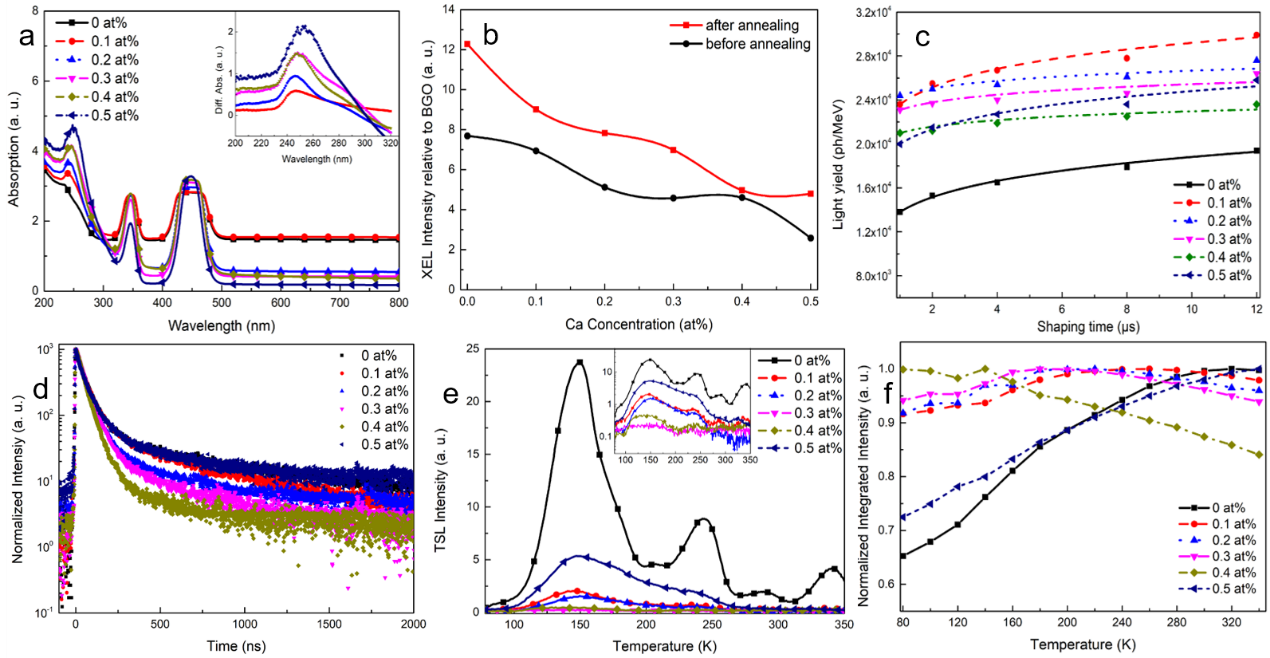Recently, researchers from Shanghai Institute of Optics and Fine Mechanics (SIOM), Chinese Academy of Sciences (CAS) made new progress in fast LuAG: Ce scintillation ceramics. The result, entitled “On fast LuAG: Ce scintillation ceramics with Ca2+ co-dopants”, was published in the Journal of the America Ceramic Society on Oct. 8, 2020.
Lutetium aluminum garnet with cerium as the luminescence center (LuAG: Ce) is one of the most promising scintillators due to its excellent scintillation performance. Especially for its great radiation hardness, LuAG: Ce ceramic scintillator has been considered to be a promising candidate for high-energy physical detectors.
However, the low light yield value and the large slow components contamination in the scintillation response have greatly limited its practical application, which is mainly related to various defects in its lattice.
In this work, researchers prepared a group of Ca2+ co-doped LuAG: Ce scintillation ceramics with the co-doping concentration varied from 0 at% to 0.5 at%. Scintillation performance parameters, such as steady-state luminescence, light yield, and scintillation decay, were measured. To investigate defects in LuAG: Ce lattice after Ca2+ co-doping, thermally stimulated luminescence measurements were also performed. It turns out that with Ca2+ co-doping, Ce4+ ions are presented in the LuAG: Ce ceramic, which provides a faster luminescence path for the scintillation process.
Although all the ceramics show high steady-state luminescence efficiency, the RL intensity gradually decreased with Ca2+ concentration increasing due to the point defects and lattice distortion introduced by Ca2+ ions. With Ca2+ co-doping, the scintillation performance of LuAG: Ce ceramics was greatly improved. There is an improvement in the light yield value and fast component percentage for all the Ca2+ co-doped ceramics. Especially for the 0.2 at% Ca2+ co-doped one, it has a high light yield value of 24, 400 ph/MeV, a fast scintillation decay time of 48 ns, and small slow component contamination. And researchers also discussed the role of Ca2+ in the scintillation mechanism of LuAG: Ce ceramics.
This work was supported by the National Key Research & Development Program of China, National Nature Science Funds of China, Youth Innovation Promotion Association of CAS, Strategic Priority Research Program of the Chinese Academy of Sciences, and General Financial Grant from China Postdoctoral Science Foundation.

Fig. Absorption spectra (a), radio luminescence (RL) spectra (b), light yield value at different shaping time (c), scintillation decay curves (d), TSL curves (d), RL intensity as a function of temperature (f) of the prepared ceramics. (Image by SIOM)
Article website:
https://doi.org/10.1111/jace.17506
Contact:
WU Xiufeng
General Administrative Office
Shanghai Institute of Optics and Fine Mechanics, CAS
Email: xfwu@siom.ac.cn
Web: http://english.siom.cas.cn/